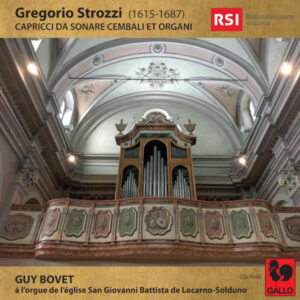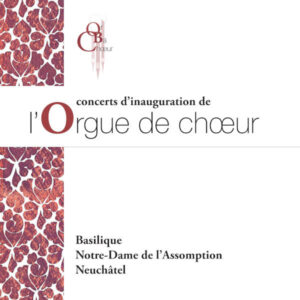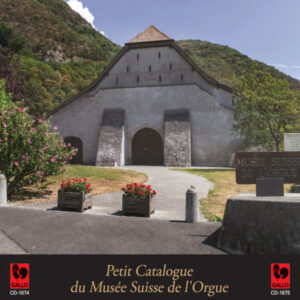Extraits / Excerpts
Works for 4 Organs of Einsiedeln - Guy Bovet, André Luy, Philippe Laubscher, Ernst Gerber
Works for 4 Organs
Père Marian MÜLLER: Sonata a quattro Organi per l’Assonta – Sonata Pastorale a quattro Organi per il Santo Natale – Sonata a tre Organi per la festa di Santo Meinrado – Anonymous: Sonata a quattro Organi in G Major – Anselm SCHUBIGER: Marcia di Santa Cecilia (Caecilienmarsch) – Carlo GOEURY: Intrada a 3 Organi – Père Marian MÜLLER: Sonata a quatro Organi per il Paschale Gaudio – Pietro VALLE: Pièce à 3 Orgues (sans titre)
Guy Bovet, https://www.guybovet.org/ André Luy, Philippe Laubscher, Ernst Gerber at the Mathis Organs and the Choir Organ of the Reformed Church of Hinwil, and at Two Positive Organs Built by Kuhn SA from Maennedorf.
The Works for Multiple Organs in the Library of Einsiedeln
The famous Einsiedeln Abbey houses many treasures in its musical library. Among these is a series of organ pieces, notably for 2, 3, or 4 organs, sometimes even with ensembles of instruments, composed for specific occasions by monks from Einsiedeln. Perhaps a passing traveler was also drawn to this stereophonic setup.
Indeed, the church in Einsiedeln had several independent organs, the cases of which are still visible today. However, the instruments themselves have unfortunately been modified to dubious tastes, now being electrically connected to a central console (with the exception of the choir organ). According to N. Flueler (Orgeln und Orgelbauten im Stift Einsiedeln, 1902), the first organ installed in the new church, completed in 1735, was an instrument taken from the previous church, built by one of the brothers, P. Pius Kreuel, in 1680. In 1741, a new organ was installed (17 stops on a keyboard and pedal) by Joseph Anderhalden from Sarnen.
The two instruments were moved in 1749 and placed at the front of the nave, on either side. At the same time, one of the two choir organs, also built by Father Kreuel, was transferred to the back of the nave, on a gallery. In 1754, Viktor Bossart from Baar completed a new choir organ with 2 manuals and 30 stops, whose mechanism extends under the entire choir, with the console on one side and the instrument on the other. Abbot Marian Müller, whose compositions appear on this disc, had the organ in the right side of the nave renovated by the organ builder Bouthillier (the instrument now had 2 manuals, a pedal, and 32 stops).
In 1797, a final instrument was begun by the Alsatian builder Bergônzle, but French troops invaded Einsiedeln, and the instrument was never completed. Including the two positive organs by Father Kreuel, the church thus had 6 or 7 organs! For this recording, we focused on the works for 3 and 4 organs from the Einsiedeln library.
We would like to thank R.P. Kanisius Zünd, the librarian, who granted us access to these treasures. Unfortunately, it was not possible to record in Einsiedeln itself, as the daily use of the sanctuary prohibited any “profane” use of the space.
From Father Marian Müller (1724-1780), abbot of Einsiedeln Abbey, four works are featured on this disc. These are single-movement sonatas in a fairly galant style, composed for specific occasions (Assumption, feast of Saint Meinrad, patron of Einsiedeln, Christmas, Easter). The instruments respond to each other in turn, with the final cadences played in unison by the four organs. For the Christmas sonata, we also used two Zimbelstern (a very popular device in the 18th century, consisting of a mechanism that strikes several little bells): one from the Mathis organ of the church in Hinwil, the other built by Max Zbinden from Luins.
Father Müller, in addition to his talents as a composer, was a great organizer, and his influence and initiatives were considerable. The organ constructions he undertook testify to this. The annals of Einsiedeln mention numerous important innovations undertaken by R.P. Müller.
Three other 18th-century composers are featured on this recording. The style of all these works is very similar, making the assumption by Rudolf Walter (Acta Organologica, vol. 5) that Pietro Valle is the composer Pietro della Valle (1586-1652) absurd. All this music is undoubtedly from the 18th century. The name Goeury (or Goevrij) is difficult to read on the manuscript. R. Walter speculates that it could be Goulit, chapel master at Notre-Dame de Paris, but his music seems somewhat un-French. As for the anonymous composer, his style is similar to that of the others.
Amid this Rococo music, R.P. Schubiger stands out with his March of Saint Cecilia. We were keen to introduce this masterpiece to the public, not only because it has invariably earned us ovations at our concerts, even in the most remote and musically austere regions, but also because this march reflects a “polyorganistic” musical culture that persisted in Einsiedeln until the mid-19th century.
Recordings of the Organs of Hinwil (ZH)
These recordings were made in August 1976 in the Reformed Church of Hinwil (ZH). The grand organ, built in 1973 by the organ builder Mathis of Näfels, has the following specifications:
| Grand Orgue (2ᵉ clavier) | Positif séparé (1ᵉʳ clavier) |
|---|---|
| Quintaton 16’ | Bourdon 8’ |
| Montre 8’ | Prestant 4’ |
| Hohflöte 8’ | Rohrflöte 4’ |
| Gambe 8’ | Nazard 2’⅔ |
| Prestant 4’ | Waldföte 2’ |
| Spitzflöte 4’ | Tierce 1’⅗ |
| Quinte 2’⅔ | Scharff 3-4 rgs 1’ |
| Octave 2’ | Cromorne 8’ |
| Mixture 3-4 rgs 1’⅓ | |
| Trompette 8’ |
| Brustwerk (3ᵉ clavier) | Pédale |
|---|---|
| Holzgedackt 8’ | Contrebasse 16’ |
| Gedacktflöte 4’ | Soubasse 16’ |
| Principal 2’ | Principal 8’ |
| Larigot 1’⅓ | Rohrgedackt 8’ |
| Cimbel 1/2’ | Octave 4’ |
| Holzregal 16’ | Mixtur 2’⅔ |
| Fagott 16’ | |
| Zinke 8’ |
Tremblant et Zimbelstern.
Choir Organ
The choir organ, built by the Metzler firm from Dietikon in 1971, has the following specifications:
| Manuel | Pédale (accouplée en permanence au clavier) |
|---|---|
| Bourdon 8’ | Soubasse 16’ |
| Principal 4’ | |
| Flûte 4’ | |
| Octave 2’ | |
| Flûte 2’ | |
| Mixture |
Positive Organs from the Kuhn Company
The two positive organs, kindly provided by the Kuhn company from Maennedorf, were built in 1972 and 1976. They have identical appearances and specifications:
| Positifs (1972 & 1976) |
|---|
| Bourdon 8’ |
| Dessus de Gambe 8’ |
| Flûte 4’ |
| Principal 2’ |
| Quinte 1’⅓ |
| Cymbale 2 rgs |
Arrangement of the Organs
For the listener in stereo or quadraphonic sound, the organs have been arranged as follows:
- Works for 4 organs: Grand organ at the back, choir organ to the front right, 1972 positive organ in the center front, and 1976 positive organ to the front left.
- Works for 3 organs (when the grand organ is not used): Choir organ to the front right, 1972 positive organ to the front left, and 1976 positive organ at the back.
- Categories
- Composers
- Interprets
- Booklet












